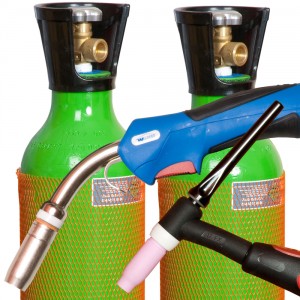01908 6998020845 899 4400 | 01908 699802Tel 01908 699802
Mig Welding Gas



Mig Welding Gas is required because it’s essential to keep Oxygen from the weld pool.
Shielding gas does this by replacing the Oxygen containing air that’s all around the weld pool.
Categories of Mig Welding Gas
Mig Welding Gas falls into two basic categories, “Inert” & “Active”.
Inert means the gas has no effect on the welding process.
Active means the gas has some effect on the welding process (more on this later!)
Types of Inert and Active Mig Welding Gas
The most commonly used Inert gas is Argon. Argon is the main shielding gas used for Tig Welding and for Mig Welding Aluminium or Mig Brazing.
The most commonly used Active Mig Welding Gas is a mixture of Argon and Co2, although Pure Co2 is also still used.
Active gases are used for Mig Welding most metals (except Aluminium and Mig Brazing, where pure Argon is used).
Co2 is the lowest cost of the Active Gases, but is far from the best.
Co2 produces a cooler, coarser, more spattery arc and a marginally harder weld. Co2 is a more challenging gas to use on thin material and not all Mig Welders perform well with 100% Co2 as a shielding gas!
An Argon/Co2 mix produces superior results as the arc is softer and smoother with the resulting weld deposit slightly softer and more malleable than where pure Co2 is used.
There are several different mixes of Argon/Co2 on the market, typically:
95% Argon + 5% Co2, is ideal for Mig Welding up to around 10mm Steel
90% Argon + 10% Co2, is ideal for Mig Welding 8-25mm Steel
80% Argon + 20% Co2, is ideal for Mig Welding 20mm plus Steel
What Inert and Active Mig Welding Gas Does
An Inert gas, such as Argon, has no effect, or reaction, on or with the welding process, it simply performs the essential task of replacing Air/Oxygen from around the weld pool.
Active gases do have an effect on the welding process. The effect of an active gas on Mig Welding is twofold:
Firstly, the Co2 content in an Argon/Co2 mix makes the gas slightly electrically conductive, this in turn raises the arc voltage, which increases penetration.
The second effect is the Co2 content breaks down the surface tension of the molten weld pool (this is the same type of surface tension that allows water to form a drip).
Using Co2 to break the surface tension of the molten weld pool allows the weld to flow and flatten slightly for the correct weld profile.
If an Inert gas is used for Mig Welding (except Aluminium and Mig Braze), higher machine power output will be needed to achieve penetration and the finished weld will look too tall because the surface tension has not been broken.
Mig Welding & Mag Welding
The use of Active Gases for most Mig Welding applications means that most operators are actually MAG welding (Metal Active Gas) rather than MIG (Metal Inert Gas) welding, however, MIG has become the generic term, despite, in fact, being inaccurate
Mig Welding Gas Cylinders
Mig Welding Gas Cylinders in the UK can be obtained in three ways:
- Disposable Cylinders which are low cost to start out with and highly portable
- Deposit based Refillable Cylinders are more expensive to initially acquire as a deposit is required, but cheaper over the longer term as the gas fills are cheaper than using disposable cylinders.
- Rental Refillable Cylinders – here the cylinder is rented from the gas company, so there’s no deposit to pay. Ongoing gas fills are usually cheaper, but overall, cylinder rental is only cheaper for higher volume gas users where the lower gas fill cost compensates for the ongoing cylinder rental cost.
I hope you found this useful, if things work out well for you, please feel free to post some pictures of your achievements on our Facebook Page
You might also find my articles on Gas Flow Rate for Mig and No Rent Gas Cylinders useful.
Please let me know what you thought of this article by leaving a comment. Don’t worry, your email address won’t be added to a database or shared and you won’t receive any unsolicited email.
Cheers
Graham
